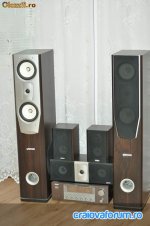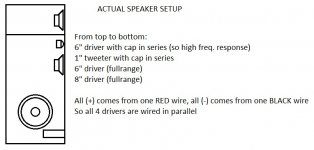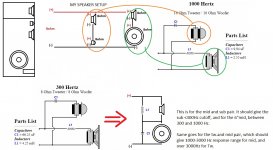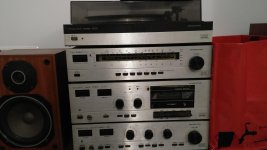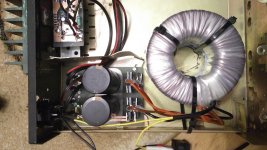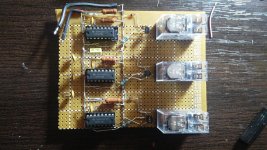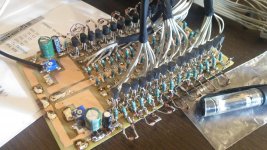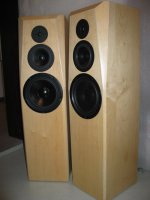Hi all,
First of all, I apologize if what I present here been discussed previously but I couldn't find anymore info about what I have and what I want to do.
The setup is an ENZER 5.1 system, from what I understand is an copy from Intervision, but without the subwoofer.
Anyway, the surrounds and center had failed and not planning on using them anyway. The amplifier will also be discarded as I'll use a Gainclone amp that I made.
I'm restoring the floorstanders. I already purchased the speakers and now I want to understand more about crossovers.
About the old setup. Speakers measures 8ohm with the multimeter. The whole speaker says on back that is 4 ohm. The wires are soldered as it follows: 4 speakers in parallel, the tweeter and one mid, each one with a cap in series, for cutting low frequencies I assume. On the Enzer amp, it states in the manual that 8ohm speaker must be connected.
Now, four 8ohm speakers in parallel, wouldn't equal 2ohm load seen on the amp ?? Wouldn't the amp fail ? Well it didn't...
The Gainclone I made, works from 4 to 8 ohm, output from ~68 to ~50 Watts.
The setup I had in mind is this: two pairs of 2 drivers in series, and the pairs in parallel. Resulting in 8ohm speaker.
I need a crossover for this and this is the point that got me.
From here on I may sound stupid but please give it a try in helping me

I want the crossover to do this:
For the bass driver response under 300Hz
For the 1st mid driver response 300-1000Hz
For the 2nd mid driver response 1000-3000Hz
For the tweeter driver response over 3000Hz.
Question 1, are this freq. ok ?
Question 2, how do I do this crossover ?
Own answer to second question is this but I don't know if it's correct or if it will work because i couldn't find much info on the internet regarding 4 ways.
So here it is. One 1st order filter at 1000 Hz, before those 2-pair series drivers. Next is one 1st order filter in series setup for tweeter (over 3000Hz) and mid (1000-3000 Hz). Next is another 1st order in series for the second mid (300-1000 Hz), and for the bass (<300Hz)
I hope i'm not sounding very stupid with this theory but this is what i'm picturing it to be from what I read.
First of all, I apologize if what I present here been discussed previously but I couldn't find anymore info about what I have and what I want to do.
The setup is an ENZER 5.1 system, from what I understand is an copy from Intervision, but without the subwoofer.
Anyway, the surrounds and center had failed and not planning on using them anyway. The amplifier will also be discarded as I'll use a Gainclone amp that I made.
I'm restoring the floorstanders. I already purchased the speakers and now I want to understand more about crossovers.
About the old setup. Speakers measures 8ohm with the multimeter. The whole speaker says on back that is 4 ohm. The wires are soldered as it follows: 4 speakers in parallel, the tweeter and one mid, each one with a cap in series, for cutting low frequencies I assume. On the Enzer amp, it states in the manual that 8ohm speaker must be connected.
Now, four 8ohm speakers in parallel, wouldn't equal 2ohm load seen on the amp ?? Wouldn't the amp fail ? Well it didn't...
The Gainclone I made, works from 4 to 8 ohm, output from ~68 to ~50 Watts.
The setup I had in mind is this: two pairs of 2 drivers in series, and the pairs in parallel. Resulting in 8ohm speaker.
I need a crossover for this and this is the point that got me.
From here on I may sound stupid but please give it a try in helping me


I want the crossover to do this:
For the bass driver response under 300Hz
For the 1st mid driver response 300-1000Hz
For the 2nd mid driver response 1000-3000Hz
For the tweeter driver response over 3000Hz.
Question 1, are this freq. ok ?
Question 2, how do I do this crossover ?
Own answer to second question is this but I don't know if it's correct or if it will work because i couldn't find much info on the internet regarding 4 ways.
So here it is. One 1st order filter at 1000 Hz, before those 2-pair series drivers. Next is one 1st order filter in series setup for tweeter (over 3000Hz) and mid (1000-3000 Hz). Next is another 1st order in series for the second mid (300-1000 Hz), and for the bass (<300Hz)
I hope i'm not sounding very stupid with this theory but this is what i'm picturing it to be from what I read.
Attachments
Stop. 
Either buy a pre-designed kit, or prepare yourself to spend a great deal of time building up to a multi-way speaker design. It is a wonderful hobby, and I find everything I learn enriching, but you are starting at the deep end of the pool. Skills are more than reading. You build them up over time with practice.
Start with a two way. You need to learn not only how to make a crossover, but what sound you like. Not to mention cabinet design.
Here's something I suggest as a good learning experience that will be cheap. Take a look at the LM-1 design which I have posted. It includes all the necessary simulation and schematics to let you start from the middle of the design process. Deconstruct and learn all about the crossover from that. Attempt your own. When you can do that, then you are ready for a 3 or more way speaker. The LM-1 takes out the need for you to do the electro-acoustic measurements. Since they are true bookshelf speakers, they also ignore the whole baffle step issues. Hah!
A Speaker Maker's Journey: The LM-1 Bookshelf Version
Also, IMHO, floor standers are over-rated. A subwoofer with it's own amp and parametric EQ is going to sound much much better.
Best of luck in your journey,
Erik
Either buy a pre-designed kit, or prepare yourself to spend a great deal of time building up to a multi-way speaker design. It is a wonderful hobby, and I find everything I learn enriching, but you are starting at the deep end of the pool. Skills are more than reading. You build them up over time with practice.
Start with a two way. You need to learn not only how to make a crossover, but what sound you like. Not to mention cabinet design.
Here's something I suggest as a good learning experience that will be cheap. Take a look at the LM-1 design which I have posted. It includes all the necessary simulation and schematics to let you start from the middle of the design process. Deconstruct and learn all about the crossover from that. Attempt your own. When you can do that, then you are ready for a 3 or more way speaker. The LM-1 takes out the need for you to do the electro-acoustic measurements. Since they are true bookshelf speakers, they also ignore the whole baffle step issues. Hah!
A Speaker Maker's Journey: The LM-1 Bookshelf Version
Also, IMHO, floor standers are over-rated. A subwoofer with it's own amp and parametric EQ is going to sound much much better.
Best of luck in your journey,
Erik
The series crossover picture seems to be good 
I'd pursue you to go that way
Some 2-3 mH coils coming along the way...for a 3-way design; more, for a 4 way. Same for capacitors: from 20 to 200 uF for mid frequencies.
I know it's a HUGE step from all (+) connected to amplifier, as before.
I'd pursue you to go that way
Some 2-3 mH coils coming along the way...for a 3-way design; more, for a 4 way. Same for capacitors: from 20 to 200 uF for mid frequencies.
I know it's a HUGE step from all (+) connected to amplifier, as before.
I like how you called it "journey" 
Mine started when I found this old system in my father in law attic, was collecting dust. It's from 1987 and I wanted to restore it, unfortunately it had some problems, radio not working good, FM was no option, amp didn't provide a clean sound, the speakers are worth going for a 2-way restore, tweeters are buzzing so needs to be replaced. I didn't get to the casette and pick-up but not going to get much hopes.
Radio did it from TDA, i have FM reception, quite clear i might say, amp is a pair of gainclones, they sound really good but need to work on accessories. i have the VU-meter working, the bass/treble (i didn't got to test it), the source select is 3-relay (this i actually test it 5 minutes ago and works great). I was planning in going for a 3-way speaker since plans were available all over the internet BUT i got this enzer for nothing, so i tought to myself, why not ?!
In their original form, this Enzers sounded ok, but lacking some fq. ranges, and i was right, as told previously, the filter is a joke and the way they are connected doesn't seem right.
The amp was buzzing but got away by replacing the big supply caps. Now they buzz a little les and i'm guessing those filter caps inside the speakers.
The harm is done, the new drivers are bought, I want this winter to get it all together.
@ Erik - I appreciate your oppinion but I can't start a new project for now at least... i'm running low on apartment space already... next you'll hear the wife kicking me and my stuff out ))
))
I tought that a 4 way might give me a little more control over the whole speaker as i can better control the sound and each driver. If I didn't had got my hand on these speakers, the project could have been a simpler one, but given this i really want to pull it through.
First of all, clear me with the actual speaker setup. Am i right saying that they are a 2ohm speaker, according to the way they are now connected ?
Second, the croosover i was planing on using, would affect the initial 8 ohm setup i did ? with 2 series pair, and them in parallel ?
Third, thank you all in advance for your support and patience in reading This is an active community and i really enjoy sharing knowledge with others. I have an account on a forum in my country and posted 3 days ago with no response... that got me here. I'm reading this forum for almost a year now, but never registered. Now this crossover got a little over my head and need help
This is an active community and i really enjoy sharing knowledge with others. I have an account on a forum in my country and posted 3 days ago with no response... that got me here. I'm reading this forum for almost a year now, but never registered. Now this crossover got a little over my head and need help 
Best of all
Mike
Mine started when I found this old system in my father in law attic, was collecting dust. It's from 1987 and I wanted to restore it, unfortunately it had some problems, radio not working good, FM was no option, amp didn't provide a clean sound, the speakers are worth going for a 2-way restore, tweeters are buzzing so needs to be replaced. I didn't get to the casette and pick-up but not going to get much hopes.
Radio did it from TDA, i have FM reception, quite clear i might say, amp is a pair of gainclones, they sound really good but need to work on accessories. i have the VU-meter working, the bass/treble (i didn't got to test it), the source select is 3-relay (this i actually test it 5 minutes ago and works great). I was planning in going for a 3-way speaker since plans were available all over the internet BUT i got this enzer for nothing, so i tought to myself, why not ?!
In their original form, this Enzers sounded ok, but lacking some fq. ranges, and i was right, as told previously, the filter is a joke and the way they are connected doesn't seem right.
The amp was buzzing but got away by replacing the big supply caps. Now they buzz a little les and i'm guessing those filter caps inside the speakers.
The harm is done, the new drivers are bought, I want this winter to get it all together.
@ Erik - I appreciate your oppinion but I can't start a new project for now at least... i'm running low on apartment space already... next you'll hear the wife kicking me and my stuff out
I tought that a 4 way might give me a little more control over the whole speaker as i can better control the sound and each driver. If I didn't had got my hand on these speakers, the project could have been a simpler one, but given this i really want to pull it through.
First of all, clear me with the actual speaker setup. Am i right saying that they are a 2ohm speaker, according to the way they are now connected ?
Second, the croosover i was planing on using, would affect the initial 8 ohm setup i did ? with 2 series pair, and them in parallel ?
Third, thank you all in advance for your support and patience in reading
Best of all
Mike
Attachments
I’d tend to agree with the bulk of Erik’s Post - certainly as regards the time and cost of learning curve for crossover design.
There are quite a few very well documented plans for multi-ways- his own LM1 among them. If you’re looking for something more complicated and expensive for an initial build, take a look at DIY-Loudspeakers
There are quite a few very well documented plans for multi-ways- his own LM1 among them. If you’re looking for something more complicated and expensive for an initial build, take a look at DIY-Loudspeakers
MKE,
You should grab XSim and do some simulations to learn about how speakers add up. If you can't make it past the LM-1, a 4 way is going to be impossible. As I mentioned, this is free, and requires no purchases for you to simulate and learn about basic crossover design. I wasn't trying to get you to build a different speaker, but to use the simulation files to learn about crossover design on the cheap.
Best,
Erik
You should grab XSim and do some simulations to learn about how speakers add up. If you can't make it past the LM-1, a 4 way is going to be impossible. As I mentioned, this is free, and requires no purchases for you to simulate and learn about basic crossover design. I wasn't trying to get you to build a different speaker, but to use the simulation files to learn about crossover design on the cheap.
Best,
Erik
Reading your initial question, you don't have the first clue of what you are doing.
That's ok, you came to the right place.
4 ways are a daunting challenge. I have an EE degree and some speaker design experience and I would not attempt it. However I am chicken and a perfectionist.
No one here can tell you if your crossover points will work or not without measurements. If the drivers are labeled and there is measurement information on the net, its not perfect but better than nothing. Otherwise, basic measurements are a must.
Without a simulation program, you are shooting in the dark. Pick one and learn it. Ask for help when needed.
Next up, let the drivers determine filter order.
Many of the commercial "first order" speakers have notch filters.
My guess is that they are an octave away from the crossover.
This gives a 4't order roll off called a Chaucer Elliptical filter.
I would find the thread here at DIY audio that recommends Speaker Build Books and read a couple. On the Net, look at 3 way design information, because the challenges are the same, if less severe.
My recommendation is to not give up.
You can do it.
Its just not going to be easy.
HTH
Doug
That's ok, you came to the right place.
4 ways are a daunting challenge. I have an EE degree and some speaker design experience and I would not attempt it. However I am chicken and a perfectionist.
No one here can tell you if your crossover points will work or not without measurements. If the drivers are labeled and there is measurement information on the net, its not perfect but better than nothing. Otherwise, basic measurements are a must.
Without a simulation program, you are shooting in the dark. Pick one and learn it. Ask for help when needed.
Next up, let the drivers determine filter order.
Many of the commercial "first order" speakers have notch filters.
My guess is that they are an octave away from the crossover.
This gives a 4't order roll off called a Chaucer Elliptical filter.
I would find the thread here at DIY audio that recommends Speaker Build Books and read a couple. On the Net, look at 3 way design information, because the challenges are the same, if less severe.
My recommendation is to not give up.
You can do it.
Its just not going to be easy.
HTH
Doug
Ok, so I took Xsim... didn't work out. Then downloaded WinPCD and actually found to be more intuitive.
The frequency and impedance files are 95% similar with those in the drivers data sheet.
Now. I know that what's in the technical details might differ from what one will actually measure inside the room, but I don't have the necessary means to do that.
I don't have a dedicated room for viewing movies, listening music etc. So what I want is something to sound good and clear in my living room.
I think I am going somewhere with the winpcd software but I need some of you to give me a go on this
I made a change of plans... I'm going with a 3-way, bass with one driver, mid with two drivers, high on the 4rd drivers.
The frequency and impedance files are 95% similar with those in the drivers data sheet.
Now. I know that what's in the technical details might differ from what one will actually measure inside the room, but I don't have the necessary means to do that.
I don't have a dedicated room for viewing movies, listening music etc. So what I want is something to sound good and clear in my living room.
I think I am going somewhere with the winpcd software but I need some of you to give me a go on this
I made a change of plans... I'm going with a 3-way, bass with one driver, mid with two drivers, high on the 4rd drivers.
Attachments
Hi all,
.............................
I want the crossover to do this:
For the bass driver response under 300Hz
For the 1st mid driver response 300-1000Hz
For the 2nd mid driver response 1000-3000Hz
For the tweeter driver response over 3000Hz.
........................
How did you choose these frequencies?
What were the criteria for choosing?
When choosing crossover frequencies you choose to maximize driver performance, to use the driver where it excels and to hide the areas where he stumbles.
Without having driver characteristics, these frequencies are meaningless.
An example of choosing crossover frequencies:
4 way speaker:
5.5in to 8 in mid-woofer (preferable 6.5in) between 120hz and 800hz (1000hz) with Xmax minim +/-2.5mm
3in dome mid between 800(1000)Hz and 4-6Khz
and a Ribon tweeter over 4-6Khz
This configuration will tend to be very expensive but besides this, the crossover frequencies are chosen so as to maximize driver performance.
double sided (for a relative small front baffle) 12in sub-woofers with minim +/-10mm Xmax (2x8ohm parallel) cut at 120-max150Hz because is side woofer;5.5in to 8 in mid-woofer (preferable 6.5in) between 120hz and 800hz (1000hz) with Xmax minim +/-2.5mm
3in dome mid between 800(1000)Hz and 4-6Khz
and a Ribon tweeter over 4-6Khz
This was only an example, not necessary a good one.
Last edited:
The SP-202PA 8" woofer in your Monacor Project file has an Fs=68Hz and will not produce any deep bass. The SP-202PA seems designed as a midrange for a PA system.I made a change of plans... I'm going with a 3-way, bass with one driver, .
Can you purchase Visaton speakers at a fair price where you live? google Sonja Visaton
The Sonja is a documented 3-way diy design using an 8" woofer from Visaton which has good reviews. You can download the free Boxsim program, and models for the Visaton drivers. German language.
Sonja.2 Bauanleitung - Visaton Diskussionsforum
Sonja GF in weiss - Visaton Diskussionsforum
One example of documented design... you can find many other successful designs to select from.
Attachments
- Status
- This old topic is closed. If you want to reopen this topic, contact a moderator using the "Report Post" button.
- Home
- Loudspeakers
- Multi-Way
- 4-way speaker stereo
